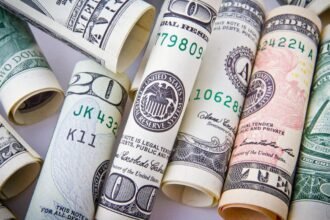The US dollar is flexing its muscles again, rallying to its highest level since November against a basket of currencies. Meanwhile, the yield on the benchmark 10-year US Treasury note hit its loftiest point since 2007.
This dynamic duo is inflicting pain on Wall Street, sending stocks tumbling as investors come to terms with the prospect of tighter financial conditions for longer.
On Tuesday, the tech-heavy Nasdaq Composite sank 1.6%, or around 9% below its July peak. The broader S&P 500 also slumped 1.5% on the day.
Not surprisingly, volatility is on the rise. The CBOE Volatility Index, Wall Street’s “fear gauge,” settled at its highest level since May. The ICE BofA MOVE Index, which measures Treasury market volatility, also jumped.
The takeaway is clear: risk aversion has taken hold.
The catalyst is equally transparent – the Federal Reserve. While the dollar and yields have been trending higher for months, the Fed’s latest policy meeting accelerated the surge to multi-year extremes.
Investors were caught flat-footed yet again, forced to abruptly price in more aggressive rate hikes for longer than previously imagined.
Climbing sovereign yields and falling bond prices are magnets for overseas capital. Global investors must first exchange their local currencies for dollars before snapping up Treasuries.
This creates a self-reinforcing loop where higher yields beget a stronger dollar, which in turn attracts more foreign bond buyers.
But the velocity of moves in highly leveraged currency and bond markets is upending the prevailing stability across global markets. The result is collateral damage for risk assets like equities.
The US dollar index is on track to close out its 11th consecutive week of gains. Barring an unexpected reversal, the greenback will become technically “overbought” on the Relative Strength Index this week – the first such signal in almost a year.
Likewise, the 10-year yield is approaching its own overbought condition on a weekly basis, also a first in 12 months.
It’s no coincidence the rally in stocks that started last October unfolded while the dollar and yields moved sideways after being overbought.
History shows overextended dollars and yields, especially simultaneous rallies, tend to spell trouble for share prices.
The last time both were overstretched was during 2022’s bear market. And those omens are resurfacing, as illustrated in the chart above.
The current anomaly is depicted as the lone purple dot. It shows that while not a steadfast rule, market turbulence often aligns with these overbought signals.
The global financial crisis and COVID-19 crash stand out as exceptions. In those cases, extreme stress in markets was driven by other factors.
If the latest moves in the dollar and yields are exhausted, the sell-off in stocks may have already priced in enough pain. That could pave the way for stocks to rebound after a healthy pullback.
But history suggests we are still weeks away from that turning point.
For stock bulls, the good news is that once the repricing in currencies and bonds ends, equities can find their footing. Eventually, yields and the dollar will settle into a new equilibrium.
That would allow risk assets like stocks to become a bit riskier again, with share prices moving higher.
Until that stability returns, stocks appear headed for more rough air pockets in the near-term. The almighty dollar strikes again.





